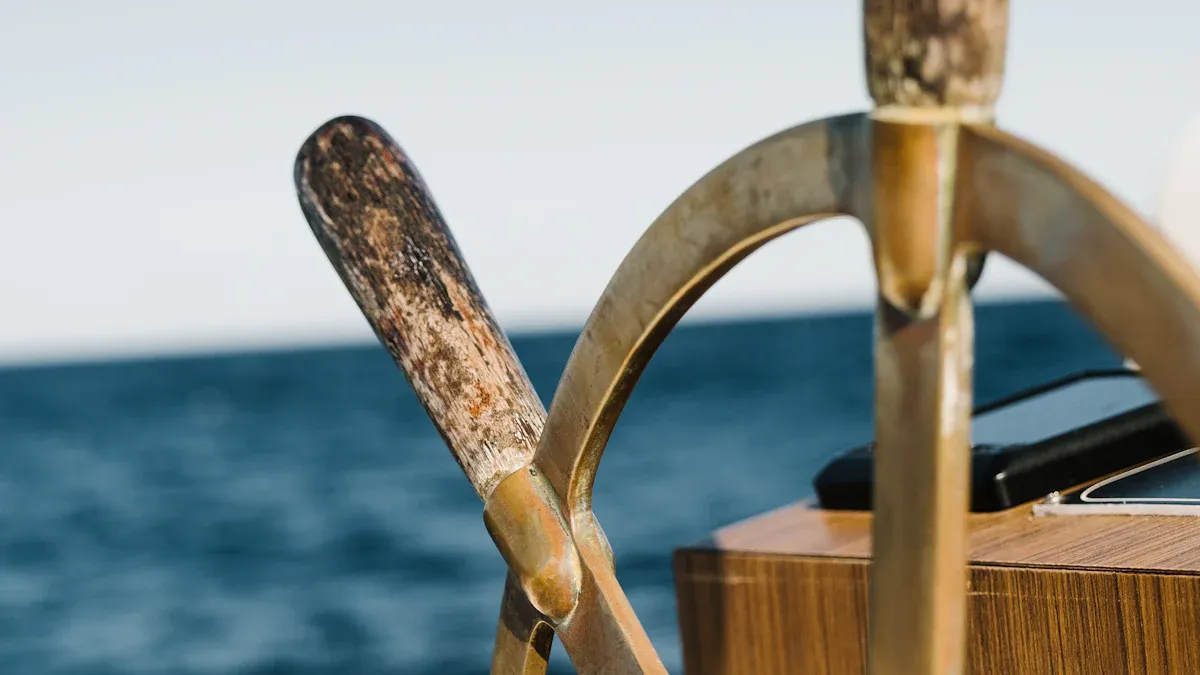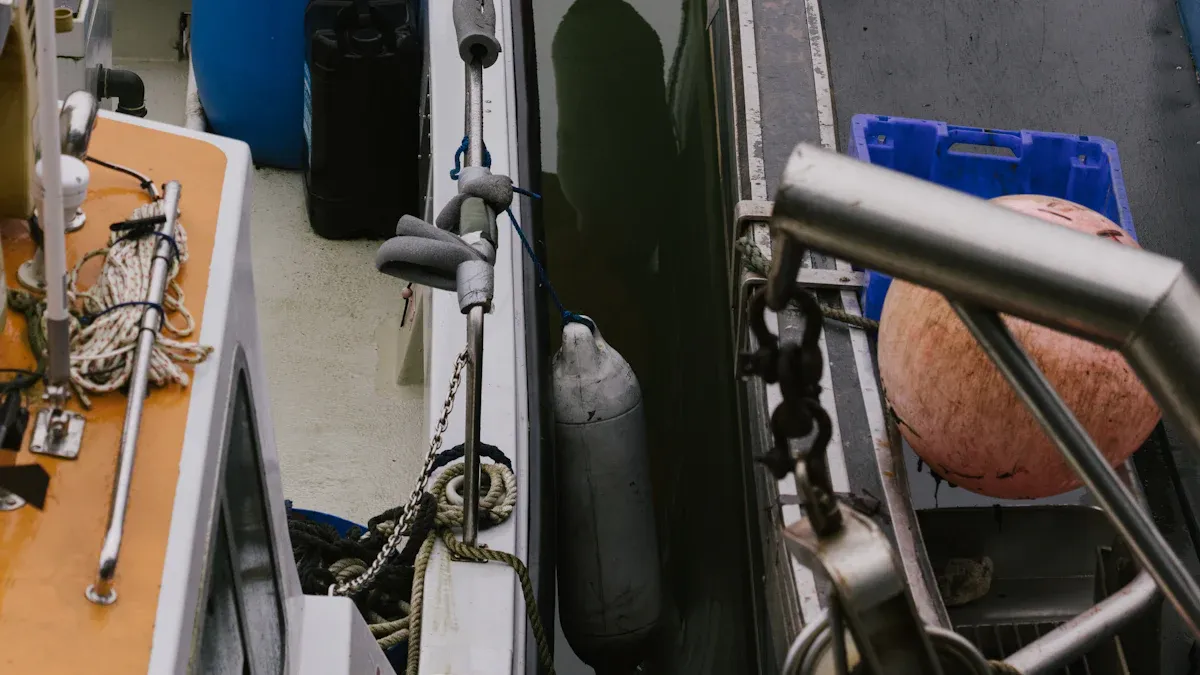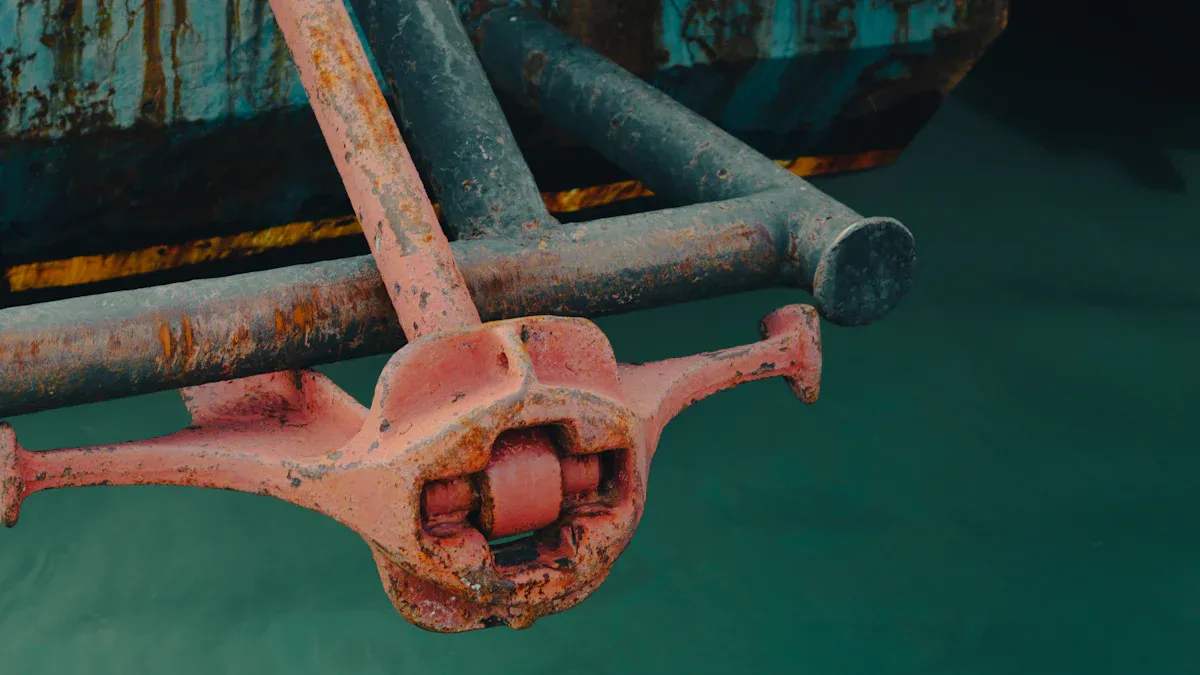
Marine hardware faces relentless challenges from harsh conditions, making material selection critical. Choosing the right alloy ensures lasting performance and reduced maintenance.
- Silicon bronze precision castings for propellers offer superior corrosion resistance, especially in saltwater, thanks to their protective oxide layer.
- Brass, while cost-effective, often suffers from dezincification, weakening its structure over time.
- Silicon bronze investment casting provides unmatched durability, ideal for high-stress applications like propellers.
The right choice of silicon bronze precision castings balances cost, strength, and longevity, ensuring reliable performance in demanding marine environments.
Key Takeaways
- Silicon bronze resists rust well, so it works great in saltwater.
- Brass is cheaper but can weaken over time in seawater.
- Picking strong materials, like silicon bronze, keeps parts lasting longer and costs lower.
Understanding Silicon Bronze and Brass
Composition and Properties of Silicon Bronze
Silicon bronze is a copper-based alloy with a small but significant amount of silicon, typically ranging from 2.5% to 6%. This composition gives it excellent corrosion resistance, especially in marine environments. Other elements like iron, manganese, and aluminum are present in trace amounts, further enhancing its strength and durability. For example:
| Element | Percentage Range |
|---|---|
| Copper | 97.5-98.5% |
| Iron | 0.3-1.4% |
| Manganese | 0.2-1% |
| Aluminum | 0.2-0.7% |
| Zinc | 0.2-1% |
| Other Elements | < 0.3% |
This alloy is known for its high strength, wear resistance, and machinability, making it ideal for marine hardware like fasteners, propellers, and U-bolts. Its ability to form a protective oxide layer ensures long-term performance in saltwater conditions.
Key Point: Silicon bronze combines strength, corrosion resistance, and machinability, making it a top choice for marine applications.
Composition and Properties of Brass
Brass, another copper-based alloy, contains a higher percentage of zinc, typically around 40%. This addition improves its strength and hardness while keeping it cost-effective. Tin, lead, and iron are also present in smaller amounts, contributing to its machinability and resistance to seawater corrosion. Here’s a breakdown:
| Element | Composition (%) | Role |
|---|---|---|
| Copper | 59.0 – 62.0 | Provides strength and corrosion resistance. |
| Zinc | ~40.0 | Adds hardness and keeps the material ductile. |
| Tin | 0.50 – 1.0 | Enhances seawater corrosion resistance. |
| Lead | Up to 0.20 | Improves machinability. |
| Iron | Max 0.10 | Contributes to hardness. |
Brass offers excellent wear resistance and adaptability to various fabrication techniques. However, it is more prone to dezincification, which can weaken its structure over time in harsh marine environments.
Key Point: Brass is versatile and cost-effective but may require careful consideration for long-term marine use.
Key Differences in Alloying Elements
The primary difference between silicon bronze and brass lies in their alloying elements. Silicon bronze relies on silicon and trace metals like manganese and aluminum to achieve its superior corrosion resistance and strength. Brass, on the other hand, uses zinc as its main alloying element, which enhances its hardness and machinability but makes it more susceptible to dezincification.
| Alloy Type | Main Alloying Elements | Key Properties |
|---|---|---|
| Silicon Bronze | Copper, Silicon | High corrosion resistance, excellent strength |
| Brass | Copper, Zinc | Cost-effective, good machinability, moderate corrosion resistance |
These differences directly impact their performance in marine environments. Silicon bronze is better suited for high-stress, corrosive conditions, while brass works well in less demanding applications.
Key Point: The choice between silicon bronze and brass depends on the specific marine application and environmental demands.
Corrosion Resistance in Marine Environments

Protective Oxide Layer of Silicon Bronze
Silicon bronze stands out in marine environments because of its ability to form a protective oxide layer. This layer acts like armor, shielding the metal from further corrosion. When exposed to air and moisture, silicon bronze undergoes a natural oxidation process that creates a green patina. This patina, made of copper carbonate and copper hydroxide, prevents deeper oxidation and keeps the material intact.
In salty, humid conditions, the protective layer becomes even more effective. Here’s how the process unfolds:
- Bronze starts by forming a copper oxide film.
- Over time, the surface converts to copper sulfate under severe exposure.
- Streaking and scab formation occur, but at a slower rate.
- Pitting spreads around scabs, though it rarely penetrates stable surfaces.
- Eventually, the material stabilizes with a bright blue-green copper sulfate finish.
This natural defense mechanism makes silicon bronze ideal for marine hardware like propellers and fasteners, where durability is critical.
Key Point: Silicon bronze’s protective oxide layer ensures long-term resistance to saltwater corrosion, making it a reliable choice for harsh marine conditions.
Dezincification in Brass
Brass, while versatile and cost-effective, faces a unique challenge in marine environments: dezincification. This process involves the selective leaching of zinc from the alloy, leaving behind a weakened copper structure. Over time, dezincification can cause leaks, bursts, and structural failures.
Marine settings, with their high chloride levels and low alkalinity, accelerate this phenomenon. Studies have shown that brass components used in plumbing systems often suffer from dezincification under similar conditions. The implications for marine hardware are clear—brass fittings and fasteners may lose their integrity in saltwater environments.
Although brass can resist corrosion to some extent, it requires careful monitoring and maintenance to prevent long-term damage.
Key Point: Dezincification limits brass’s durability in marine applications, making it less suitable for high-stress or long-term use.
Real-World Examples of Corrosion Resistance
Silicon bronze and brass have both been used in marine applications, but their performance varies significantly. Here’s a quick comparison:
| Application | Material Used | Benefit |
|---|---|---|
| Propeller Shafts | Silicon Bronze | Exceptional resistance to saltwater corrosion |
| Marine Fastenings | Silicon Bronze | Secure and corrosion-resistant connections |
Silicon bronze consistently outperforms brass in environments where saltwater exposure is constant. For example, propeller shafts made from silicon bronze maintain their structural integrity even after years of use. Similarly, marine fastenings crafted from silicon bronze provide secure connections without the risk of corrosion-related failures.
Key Point: Real-world applications highlight silicon bronze’s superior corrosion resistance, making it the preferred choice for critical marine hardware.
Mechanical Properties and Durability
Strength-to-Weight Ratio of Silicon Bronze
Silicon bronze stands out for its impressive strength-to-weight ratio. This property makes it a favorite for marine hardware, where both durability and lightweight materials are essential. The alloy’s high copper content, combined with silicon and trace elements, creates a material that can withstand significant stress without adding unnecessary weight. This balance is particularly important for components like propellers, where excessive weight could reduce efficiency and increase fuel consumption.
In comparison, brass, while strong, doesn’t match the strength-to-weight ratio of silicon bronze. Its higher zinc content contributes to its density, making it heavier and less ideal for applications requiring lightweight durability. For marine engineers, this difference often tips the scale in favor of silicon bronze, especially for high-performance parts like propeller shafts and fasteners.
Key Point: Silicon bronze offers a superior strength-to-weight ratio, making it ideal for marine hardware that demands both durability and efficiency.
Wear Resistance and Fatigue Performance
When it comes to wear resistance, silicon bronze outshines many other alloys, including brass. Its unique composition allows it to endure repeated friction and stress without significant degradation. Laboratory tests have shown that siliconized aluminum bronze, a variant of silicon bronze, exhibits a Vickers hardness of 524.5 HV1—nearly double that of non-siliconized samples. This 93.54% increase in hardness translates to exceptional wear resistance, even under challenging conditions.
Additionally, the friction coefficient of siliconized samples is reduced to just 40.38% of non-siliconized ones. This means silicon bronze maintains a stable lubricating oil film during prolonged use, as demonstrated in a 90-minute friction test. These properties make it a reliable choice for marine hardware exposed to constant motion, such as propellers and bearings.
Brass, while offering decent wear resistance, doesn’t perform as well under prolonged stress. Its susceptibility to dezincification further compromises its fatigue performance over time. For marine applications requiring long-term reliability, silicon bronze remains the preferred option.
Key Point: Silicon bronze’s superior hardness and reduced friction make it highly resistant to wear and fatigue, ensuring long-lasting performance in marine environments.
Case Study: Silicon Bronze Precision Castings for Propellers
Silicon bronze precision castings for propellers have become a benchmark for durability and performance in the marine industry. Propellers operate in one of the harshest environments, constantly exposed to saltwater, high pressure, and mechanical stress. Silicon bronze’s ability to resist corrosion and wear makes it the material of choice for these critical components.
For instance, a leading marine engineering firm replaced traditional brass propellers with silicon bronze precision castings. The results were remarkable. The new propellers demonstrated enhanced resistance to pitting and cracking, even after years of operation in saltwater. Additionally, their lightweight nature improved fuel efficiency, reducing operational costs for the vessel.
This case highlights why silicon bronze precision castings for propellers are a go-to solution for marine hardware. Their combination of strength, corrosion resistance, and wear performance ensures reliable operation, even in the most demanding conditions.
Key Point: Silicon bronze precision castings for propellers deliver unmatched durability and efficiency, making them a top choice for marine applications.
Cost Comparison and Long-Term Value
Initial Costs of Silicon Bronze vs. Brass
Silicon bronze typically costs more than brass due to its higher copper content and the addition of silicon. These elements enhance its mechanical properties and corrosion resistance, making it a premium choice for marine hardware. Brass, on the other hand, is more affordable upfront, thanks to its higher zinc content and simpler composition.
However, the initial expense of silicon bronze often pays off in the long run. Its durability and resistance to saltwater corrosion reduce the need for frequent replacements. For marine applications where reliability is critical, the upfront investment in silicon bronze proves worthwhile.
Tip: While brass may seem budget-friendly initially, silicon bronze offers better value over time due to its longevity.
Maintenance and Replacement Costs
Silicon bronze requires minimal maintenance, even in harsh marine environments. Its natural ability to form a protective oxide layer ensures long-term performance without significant upkeep. This reduces the frequency of repairs and replacements, saving both time and money.
Brass, while cost-effective initially, demands more attention. Its susceptibility to dezincification can lead to structural failures, especially in saltwater. Over time, the costs of repairing or replacing brass components can outweigh the savings from its lower initial price.
For marine hardware exposed to constant stress and corrosion, silicon bronze emerges as the more economical choice in the long run.
Key Point: Investing in silicon bronze minimizes maintenance and replacement costs, making it a cost-effective solution for marine hardware.
Examples of Cost-Effective Marine Hardware Choices
The choice between silicon bronze and brass depends on the application and environmental demands. Here’s a quick comparison:
| Material | Application | Corrosion Resistance |
|---|---|---|
| Silicon Bronze | Ship fittings, propellers, fasteners | Superior in marine environments |
| Brass | General hardware | Less resistant to saltwater |
Silicon bronze is ideal for critical components like propellers and underwater fasteners, where durability and corrosion resistance are essential. Brass works well for less demanding applications, such as general hardware, where exposure to saltwater is limited.
Key Point: Selecting the right material for the job ensures cost-effectiveness and long-term reliability in marine environments.
Practical Applications and Recommendations

Best Uses for Silicon Bronze in Marine Hardware
Silicon bronze excels in marine environments due to its exceptional resistance to saltwater corrosion. Its durability and hardness make it a reliable choice for components exposed to mechanical stress. For example, silicon bronze precision castings for propellers are widely used because they maintain structural integrity even under constant exposure to saltwater. This alloy is also ideal for fasteners, pump components, and valve fittings, where long-term performance is critical.
The alloy’s strength and machinability further enhance its versatility. It performs well in architectural applications and corrosive environments, as shown by its Brinell hardness range of 90-140 BHN. While its machinability is rated as fair, its ability to withstand wear and tear makes it a top choice for marine hardware.
Key Point: Silicon bronze is the go-to material for high-stress, corrosive marine applications like propellers and fasteners.
When Brass Is a Suitable Alternative
Brass offers a cost-effective alternative for less demanding marine applications. Its antimicrobial properties make it a good choice for environments where hygiene matters, such as plumbing systems on ships. The addition of tin enhances its corrosion resistance and thermal stability, making it suitable for fittings and non-structural components.
However, brass is best used in applications with limited saltwater exposure. It works well for general hardware, decorative elements, and low-stress components. While it doesn’t match the corrosion resistance of silicon bronze, its affordability and versatility make it a practical option for certain marine uses.
Key Point: Brass is a budget-friendly choice for low-stress applications where saltwater exposure is minimal.
Factors to Consider When Choosing Between the Two
Selecting the right material depends on the application and environmental demands. Silicon bronze offers superior corrosion resistance, making it ideal for marine fittings and components exposed to saltwater. Brass, while less resistant, provides a cost-effective solution for general hardware and decorative purposes.
Here’s a quick comparison to guide decision-making:
| Alloy Type | Corrosion Resistance | Typical Applications |
|---|---|---|
| Silicon Bronze | Good resistance to saltwater corrosion | Marine fittings, propellers, fasteners |
| Brass | Moderate resistance to corrosion | Decorative hardware, plumbing systems |
For critical components like propellers, silicon bronze precision castings for propellers deliver unmatched durability and efficiency. Brass, on the other hand, suits applications where cost is a priority and exposure to harsh conditions is limited.
Key Point: Consider the environment, stress levels, and budget when choosing between silicon bronze and brass for marine hardware.
Silicon bronze and brass each serve unique purposes in marine hardware. Silicon bronze, with its 2.5-6% silicon composition, offers unmatched corrosion resistance and durability, making it perfect for underwater fastenings and propellers. Brass, while cost-effective, suits less demanding applications.
- Key Takeaway: For long-term reliability in harsh marine environments, silicon bronze is the superior choice.
FAQ
1. Why is silicon bronze better for marine hardware than brass?
Silicon bronze resists saltwater corrosion better than brass. Its protective oxide layer ensures durability, making it ideal for high-stress marine applications like propellers and fasteners.
2. Can brass be used in saltwater environments?
Brass can work in saltwater but is prone to dezincification. It’s better suited for low-stress applications or areas with limited saltwater exposure.
3. Is silicon bronze worth the higher cost?
Yes! Silicon bronze lasts longer and requires less maintenance. Its durability and corrosion resistance make it a cost-effective choice for critical marine hardware over time.
